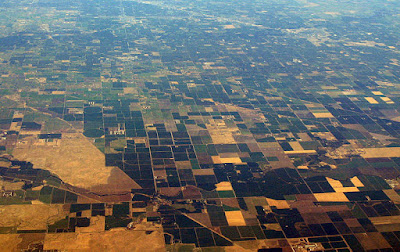Agro-ecological Dilemmas in California�s Central Valley
From Wikimedia Commons: The California Central Valley as seen from 20,000 feet. This is a south-facing view of the area north of Modesto, and east of Stockton and Manteca, as identified by comparison with aerial photography.
By Geoffrey Mohan, reporting from Fresno for the Los Angeles Times (December 31, 2015)
�It should have been a good year for turning wood and waste into electrons. A record-setting drought forced growers to bulldoze thousands of acres of trees, and hardly anyone in the Central Valley has permission to light bonfires anymore. But more than trees have withered in California�s sun. The state�s biomass energy plants are folding in rapid succession, unable to compete with heavily subsidized solar farms, many of which have sprouted up amid the fields and orchards of the San Joaquin Valley. Paul Parreira is painfully aware of the irony. The third-generation grower and almond processor is running out of dirt roads where he can spread ground-up almond shells, even as he expands a one-megawatt solar array on six acres of his family's property in Los Banos.
The waste-to-energy facilities where Parreira used to send about 50,000 tons of shells per year are vanishing. Six have closed in just two years, the latest in Delano, which shut down Thursday, after San Diego Gas & Electric ended its power purchase agreement. Twenty-five people were laid off, and 19 will remain to complete closure of the plant, said Dennis Serpa, fuels manager of the 50-megawatt plant, owned and operated by Covanta.
The Rio Bravo biomass facility south of Fresno is taking some of the fuel that would have gone to Delano. But short of a miracle, the 25-megawatt plant run by IHI Power Services Corp. will burn its last wood chips in July, when its power purchase agreement with Pacific Gas & Electric Co. expires. The Sacramento Municipal Utility District, meanwhile, is locked in a dispute with the 18-megawatt Buena Vista biomass facility in Ione, and has threatened to terminate its contract, according to district spokesman Christopher Capra.
The closures have forced the San Joaquin Valley Air Pollution Control District to consider allowing more agricultural waste to be burned in open piles, which produces particulate matter and ozone-forming compounds associated with cardiovascular illnesses. Air quality already is notoriously bad throughout the district � four of the five dirtiest metropolitan areas, based on ozone and particulate measures, are in the valley, according to the American Lung Assn. Based only on measures of particulate matter, the Fresno-Madera area was the worst in the nation, followed by Bakersfield, Visalia-Porterville-Hanford, and Modesto-Merced. [emphasis added]
A policy change on open burning would require extensive public hearings. But the district may have little choice.� [�.]
The rest of the article from the Los Angeles Times is here.


Comments
Post a Comment